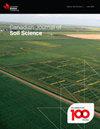初耕后未扰动土壤的甘蔗田的压实度、通气性和土壤保水指数
IF 1.5
4区 农林科学
Q4 SOIL SCIENCE
引用次数: 0
摘要
作物生长初期土壤耕作后的土壤板结一直是农作物田间的一个主要问题,因为它对土壤功能和作物生长产生了有害影响。因此,本研究旨在确定巴西南部沙质壤土(Dystrophic Paleudalf)在甘蔗作物种植初期采用不同耕作方法但未耕作两季的土壤板结程度、土壤空气容量、近地表最佳比率和保水特性。最初的土壤耕作制度包括:NT:免耕;NTC:压实免耕;CT:常规耕作;Ch:凿开免耕。对 0 - 10、10 - 20、20 - 40 和 40 - 60 厘米层的扰动和未扰动土壤进行取样,以测定压实度、空气容量、近表层最佳比率、土壤保水特性和土壤物理质量指数 S。最初,NT 处理的压实度明显最低(p < 0.05)(87%),土壤空气容量(0.104 cm3 cm-3)、空气容量/总孔隙度比率(0.261)最高,表层保水特性更好。随着时间的推移,Ch 改良了地下土层的结构,压实度最低(≈ 88%),空气容量最大(≈ 0.140 cm3 cm-3),而 NTC 的测量指标较差。在没有土壤扰动的年份里,无论耕作与否,表层都表现出较强的恢复能力,压实程度低,保水性和空气容量都有所提高。在甘蔗生产中,免耕可能是一种很好的土壤管理方法,而机械凿毛则可改善板结的土壤。本文章由计算机程序翻译,如有差异,请以英文原文为准。
Degree of compaction, aeration, and soil water retention indices of a sugarcane field without soil disturbance after initial tillage
Soil compaction after initial soil tillage for crop establishment has been a major problem in crop fields because of its deleterious effects on soil functioning and crop performance. Therefore, the study aimed to determine the degree of compaction, soil air capacity, near-surface optimum ratios and water retention characteristics in a sandy loam, Dystrophic Paleudalf initially under different tillage methods for sugarcane crop but without tillage for two seasons in southern Brazil. Initial soil tillage systems consisted of NT: no-tillage; NTC: compacted no-tillage; CT: conventional tillage; and Ch: chiseling of no-tillage. Disturbed and undisturbed soil was sampled from 0 - 10, 10 - 20, 20 - 40 and 40 - 60 cm layers to determine degree of compaction, air capacity, near-surface optimum ratios, soil water retention characteristics, and soil physical quality index S. At initial, NT treatment had the significantly (p < 0.05) lowest degree of compaction (87%), highest soil air capacity (0.104 cm3 cm-3), air capacity/total porosity ratio (0.261) and better water retention characteristics in the surface layer. Over time, Ch had improved the structure of the subsurface soil layers with lowest degree of compaction (≈ 88%) and highest air capacity (≈ 0.140 cm3 cm-3) while the measured indices were poor in NTC. Irrespective of tillage, the surface layer showed resilience during the years without soil disturbance with low degree of compaction, increased water retention and air capacity. No-tillage could be a good soil management option for sugarcane production while mechanical chiseling is advocated for ameliorating compacted soils.
求助全文
通过发布文献求助,成功后即可免费获取论文全文。
去求助
来源期刊

Canadian Journal of Soil Science
农林科学-土壤科学
CiteScore
2.90
自引率
11.80%
发文量
73
审稿时长
6.0 months
期刊介绍:
The Canadian Journal of Soil Science is an international peer-reviewed journal published in cooperation with the Canadian Society of Soil Science. The journal publishes original research on the use, management, structure and development of soils and draws from the disciplines of soil science, agrometeorology, ecology, agricultural engineering, environmental science, hydrology, forestry, geology, geography and climatology. Research is published in a number of topic sections including: agrometeorology; ecology, biological processes and plant interactions; composition and chemical processes; physical processes and interfaces; genesis, landscape processes and relationships; contamination and environmental stewardship; and management for agricultural, forestry and urban uses.
 求助内容:
求助内容: 应助结果提醒方式:
应助结果提醒方式:


